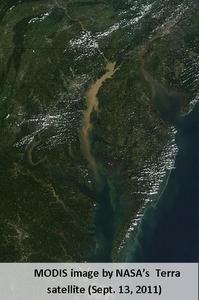 In 2011, Tropical Storm Lee dropped 102 to 178 mm (4 to 7 in.) of rain on the Susquehanna River Basin in 4 days, creating a plume of 17 million megagrams (19 million tons) of sediment that extended 161 km (100 mi) into Chesapeake Bay.
In 2011, Tropical Storm Lee dropped 102 to 178 mm (4 to 7 in.) of rain on the Susquehanna River Basin in 4 days, creating a plume of 17 million megagrams (19 million tons) of sediment that extended 161 km (100 mi) into Chesapeake Bay.
Based on initial forecasts, Superstorm Sandy, which hit the U.S. East Coast at the end of October, looked like it might produce similar results. Due to climate change, some experts anticipate that high-flow events like Sandy and Lee will become more frequent and severe, and they are a significant source of stormwater pollution.
During the past decade, Tropical Storm Lee represented only 1.8% of the Susquehanna’s flow to the bay but contributed 22% of the phosphorus and 39% of the sediment, according to a 2012 report released by the U.S. Geological Survey (USGS). In 2011 alone, Lee contributed 78% of the sediment flowing into the bay from the Susquehanna River.
Trouble behind the dam
In the Chesapeake Bay, high flow events further affect water quality due to aging dams on the Susquehanna River — the largest tributary feeding into the bay. The Susquehanna is also the largest source of sediment and phosphorus to the bay, and more than 91 million megagrams (100 million tons) of sediment lie behind the 84-year-old Conowingo Dam near the river’s mouth.
Over the years, sediment has filled the reservoir to about 85% of its capacity, and researchers estimate that it will be full by 2020.
As reservoir capacity decreases, so does the reservoir’s ability to trap sediment and nutrients, especially during flood events. Because of this, contributions from the Susquehanna River are already undermining efforts to comply with the Chesapeake Bay total maximum daily load, which targets sediment, nitrogen, and phosphorus.
“Even with control measures upstream, which we think are fairly effective, we are actually seeing an increase in phosphorus flowing into the bay from the Susquehanna River,” Hirsch said.
Once the reservoir reaches its sediment storage capacity, a 250% increase in sediment and 70% increase in phosphorus is expected, compared to mid-1990s levels, according to a 1997 USGS report.
Monitoring and maintenance
“The lesson about this reservoir is the importance of monitoring BMPs and assessing their effectiveness, because effectiveness can change significantly over time,” Hirsch said. “A few decades ago, Conowingo Dam was trapping a significant amount of sediment and phosphorus. Now, it is becoming a source.”
“You can’t just assume that a BMP will continue to work the same way decade after decade; you have to monitor and analyze the data to see what is happening,” Hirsch said.
Finding solutions
Researchers working on the Lower Susquehanna River Watershed Assessment are reviewing solutions to reservoir sedimentation. The primary option under review is reservoir dredging. However, this option is expensive; the sediments must be stable on the landscape, once moved; and they contain legacy pollutants.
Another option is allowing sediment to bypass the reservoir and moving it into the bay during late fall or winter. During this time, phosphorus is less biologically active and would be less likely to harm the bay.
Broader implications
Serena McClain, director of river restoration at American Rivers, estimates that there are about 100,000 dams in the U.S., many of which are older, smaller dams that have filled in.
“Dams weren’t built to manage sediment, and most don’t have sediment management plans behind them,” McClain said.
And, stormwater management solutions must focus on both large and small storms. Small events, such as 1.5 year storms, generate more sediment delivery over time. However, large pulses associated with high flow events may have more immediate adverse impacts on water quality.
Unfortunately, in the Susquehanna River Basin, “sedimentation seen today is not really driven by current land use practices but by agricultural practices used 100 years ago,” Hirsch said. The sediment eroded and deposited in flood plains and reservoirs from agricultural land upstream is gradually being eroded by the storms that pass through.



